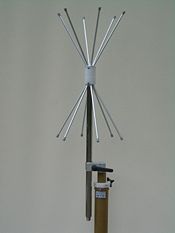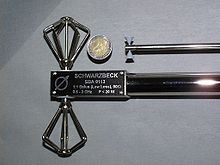
Biconical antenna
Encyclopedia
In radio
systems, a biconical antenna is a broad-bandwith antenna made of two roughly conical conductive objects, nearly touching at their points. Biconical antennas are broadband dipole antennas, typically exhibiting a bandwidth of 3 octaves
or more.
 The conical conductors need not be solid cones nor infinitely long. A simple conical monopole antenna is a wire approximation of the solid biconical antenna and has increased bandwidth (over a simple monopole). A bowtie antenna is simple broadband wire approximation in two dimensions of a biconic dipole antenna (used, for example, for UHF
The conical conductors need not be solid cones nor infinitely long. A simple conical monopole antenna is a wire approximation of the solid biconical antenna and has increased bandwidth (over a simple monopole). A bowtie antenna is simple broadband wire approximation in two dimensions of a biconic dipole antenna (used, for example, for UHF
television reception). A common variant is the Discone antenna
, where one of the cones has a vertex angle of 180 degree
s (or is reduced to a plane
).
The biconical antenna has a broad bandwidth because it is an example of a travelling wave structure; the analysis for a theoretical infinite antenna resembles that of a transmission line
. For an infinite antenna, the characteristic impedance
at the point of connection is a function of the cone angle only and is independent of the frequency. Practical antennas have finite length and a definite resonant frequency.
Biconical (or "Bicon") antennas are often used in electromagnetic interference (EMI) testing either for immunity testing, or emissions testing. While the Bicon is very broadband, it exhibits poor efficiency at low frequencies, resulting in low field strengths when compared to the input power. Log periodic dipole arrays, yagi-uda arrays, and reverberation chambers have shown to achieve much higher field stregths for the power input than a simple biconical antenna in an anechoic chamber.

Radio
Radio is the transmission of signals through free space by modulation of electromagnetic waves with frequencies below those of visible light. Electromagnetic radiation travels by means of oscillating electromagnetic fields that pass through the air and the vacuum of space...
systems, a biconical antenna is a broad-bandwith antenna made of two roughly conical conductive objects, nearly touching at their points. Biconical antennas are broadband dipole antennas, typically exhibiting a bandwidth of 3 octaves
Octave (disambiguation)
An octave, in music, is the interval between one musical pitch and another with half or double its frequency.'Octave' may also refer to:- Computing :* GNU Octave, a program for performing numerical analysis, mostly compatible with MATLAB...
or more.

Ultra high frequency
Ultra-High Frequency designates the ITU Radio frequency range of electromagnetic waves between 300 MHz and 3 GHz , also known as the decimetre band or decimetre wave as the wavelengths range from one to ten decimetres...
television reception). A common variant is the Discone antenna
Discone antenna
A discone antenna is a version of a biconical antenna in which one of the cones is replaced by a disc. It is usually mounted vertically, with the disc at the top and the cone beneath....
, where one of the cones has a vertex angle of 180 degree
Degree (angle)
A degree , usually denoted by ° , is a measurement of plane angle, representing 1⁄360 of a full rotation; one degree is equivalent to π/180 radians...
s (or is reduced to a plane
Plane (mathematics)
In mathematics, a plane is a flat, two-dimensional surface. A plane is the two dimensional analogue of a point , a line and a space...
).
The biconical antenna has a broad bandwidth because it is an example of a travelling wave structure; the analysis for a theoretical infinite antenna resembles that of a transmission line
Transmission line
In communications and electronic engineering, a transmission line is a specialized cable designed to carry alternating current of radio frequency, that is, currents with a frequency high enough that its wave nature must be taken into account...
. For an infinite antenna, the characteristic impedance
Characteristic impedance
The characteristic impedance or surge impedance of a uniform transmission line, usually written Z_0, is the ratio of the amplitudes of a single pair of voltage and current waves propagating along the line in the absence of reflections. The SI unit of characteristic impedance is the ohm...
at the point of connection is a function of the cone angle only and is independent of the frequency. Practical antennas have finite length and a definite resonant frequency.
Biconical (or "Bicon") antennas are often used in electromagnetic interference (EMI) testing either for immunity testing, or emissions testing. While the Bicon is very broadband, it exhibits poor efficiency at low frequencies, resulting in low field strengths when compared to the input power. Log periodic dipole arrays, yagi-uda arrays, and reverberation chambers have shown to achieve much higher field stregths for the power input than a simple biconical antenna in an anechoic chamber.

See also
- Discone antennaDiscone antennaA discone antenna is a version of a biconical antenna in which one of the cones is replaced by a disc. It is usually mounted vertically, with the disc at the top and the cone beneath....
- Antenna
- RadioRadioRadio is the transmission of signals through free space by modulation of electromagnetic waves with frequencies below those of visible light. Electromagnetic radiation travels by means of oscillating electromagnetic fields that pass through the air and the vacuum of space...
- TelevisionTelevisionTelevision is a telecommunication medium for transmitting and receiving moving images that can be monochrome or colored, with accompanying sound...
- Electromagnetic reverberation chamberElectromagnetic Reverberation ChamberAn electromagnetic reverberation chamber is an environment for electromagnetic compatibility testing and other electromagnetic investigations. Electromagnetic reverberation chambers have been introduced first by H.A. Mendes in 1968...
- Electromagnetic CompatibilityElectromagnetic compatibilityElectromagnetic compatibility is the branch of electrical sciences which studies the unintentional generation, propagation and reception of electromagnetic energy with reference to the unwanted effects that such energy may induce...

